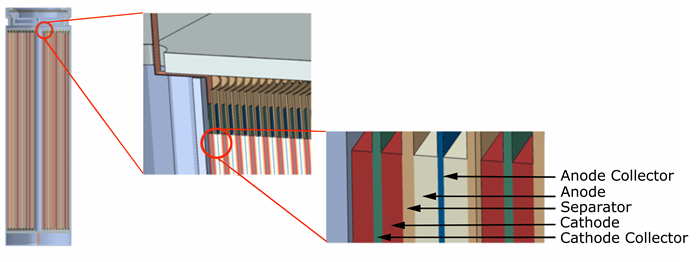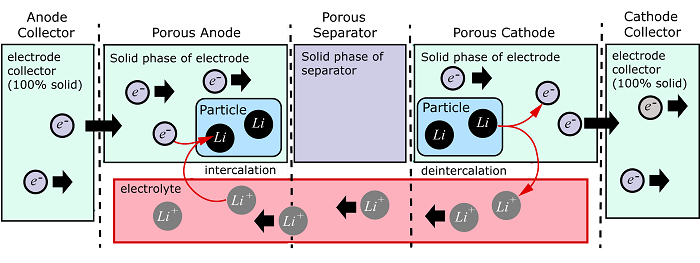Battery electrochemical simulation | ||
| ||
Products Abaqus/Standard
Lithium-ion batteries have emerged as rechargeable energy storage devices for widespread use in a variety of industries, including portable electronics and the automotive industry. The advantages of a lithium-ion battery include high energy density, low maintenance, and improved electrochemical performance compared to other cell chemistries. Accurate physics-based computer simulation of the battery electrochemistry process can lead to better cell designs. These simulations can provide significant information about the cell's ability to sustain its capacity under different loading conditions, aging due to repetitive charge-discharge cycles, and insights into conditions that could lead to thermal runaways.
A full stack lithium-ion battery cell consists of an anode collector, porous anode, porous separator, porous cathode, and cathode collector. Figure 1 shows a typical jelly roll configuration of a cylindrical battery. The porous parts of the battery are immersed in an electrolyte bath that facilitates the movement of ions from the cathode to the anode during the charging cycle (Figure 2).


The coupled thermal-electrochemical, fully coupled thermal-electrochemical-structural, and the new fully coupled thermal-electrochemical-structural–pore pressure procedures are intended for the analysis of battery electrochemistry applications. Using an extended three-dimensional Porous Electrode Theory (PET) Newman model, the fully coupled analysis solves simultaneously for the following highly coupled fields: displacements, pore pressure, temperature, electric potentials in the solid and electrolyte phases, ion concentration in the electrolyte, and concentration in the solid particles in the electrodes. You can use nonuniform and uniform meshes. Only brick elements are supported, which prove to be sufficient for all commercial cell designs, including all cylindricals, pouches, and prismatics.
A new surface-based Butler-Volmer load and surface-based Butler-Volmer interaction are available to model solid electrodes in lithium metal batteries. This allows for better computational efficiency by eliminating the need to solve for the microscale solution in a solid electrode.
Abaqus Analysis Guide
Abaqus Keywords Guide
Abaqus Prescribed Conditions Guide